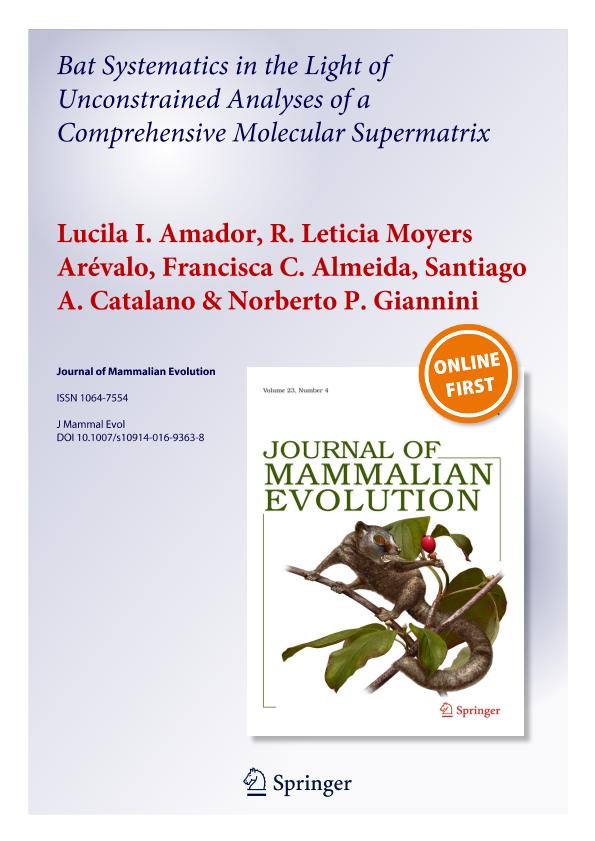Artículo
Bat Systematics in the Light of Unconstrained Analyses of a Comprehensive Molecular Supermatrix
Amador, Lucila Inés ; Moyers Arévalo, Reyna Leticia
; Moyers Arévalo, Reyna Leticia ; Cunha Almeida, Francisca
; Cunha Almeida, Francisca ; Catalano, Santiago Andres
; Catalano, Santiago Andres ; Giannini, Norberto Pedro
; Giannini, Norberto Pedro
 ; Moyers Arévalo, Reyna Leticia
; Moyers Arévalo, Reyna Leticia ; Cunha Almeida, Francisca
; Cunha Almeida, Francisca ; Catalano, Santiago Andres
; Catalano, Santiago Andres ; Giannini, Norberto Pedro
; Giannini, Norberto Pedro
Fecha de publicación:
03/2018
Editorial:
Springer
Revista:
Journal of Mammalian Evolution
ISSN:
1064-7554
Idioma:
Inglés
Tipo de recurso:
Artículo publicado
Clasificación temática:
Resumen
Bats (Chiroptera) represent the largest diversification of extant mammals after rodents. Here we report the results of a large-scale phylogeny of bats based on unconstrained searches for a data matrix of 804 non-chimeric, taxonomically updated bat terminals (796 species represented by a single terminal plus three species represented by ≥2 genetically distinct subspecies), able to preliminary test the systematics of most groups simultaneously. We used nine nuclear and mitochondrial DNA sequence markers fragmentary represented for ingroups (c. 90% and 64% of extant diversity at genus and species level, respectively) and 20 diverse placental outgroups. Maximum Likelihood and Parsimony analyses applied to the concatenated dataset yielded a highly resolved, variously supported phylogeny that recovered the majority of currently recognized clades at all levels of the chiropteran tree. Calibration points based on 44 key fossils allowed the Bayesian dating of bat origins at c. 4 my after the K-Pg boundary, and the determination of stem and crown ages of intraordinal clades. As expected, bats appeared nested in Laurasiatheria and split into Yinpterochiroptera and Yangochiroptera. More remarkable, all polytypic, currently recognized families were monophyletic, including Miniopteridae, Cistugidae, and Rhinonycteridae, as well as most polytypic genera with few expected exceptions (e.g., Hipposideros). The controversial Myzopodidae appeared in a novel position as sister of Emballonuroidea―a result with interesting biogeographic implications. Most recently recognized subfamilies, genera, and species groups were supported or only minor adjustments to the current taxonomy would be required, except Molossidae, which should be revised thoroughly. In light of our analysis, current bat systematics is strongly supported at all levels; the emergent perception of a strong biogeographic imprint on many recovered bat clades is emphasized.
Palabras clave:
Chiroptera
,
Maximum Likelihood
,
Molecular Dating
,
Parsimony
,
Phylogeny
Archivos asociados
Licencia
Identificadores
Colecciones
Articulos(UEL)
Articulos de UNIDAD EJECUTORA LILLO
Articulos de UNIDAD EJECUTORA LILLO
Citación
Amador, Lucila Inés; Moyers Arévalo, Reyna Leticia; Cunha Almeida, Francisca; Catalano, Santiago Andres; Giannini, Norberto Pedro; Bat Systematics in the Light of Unconstrained Analyses of a Comprehensive Molecular Supermatrix; Springer; Journal of Mammalian Evolution; 25; 1; 3-2018; 37-70
Compartir
Altmétricas



